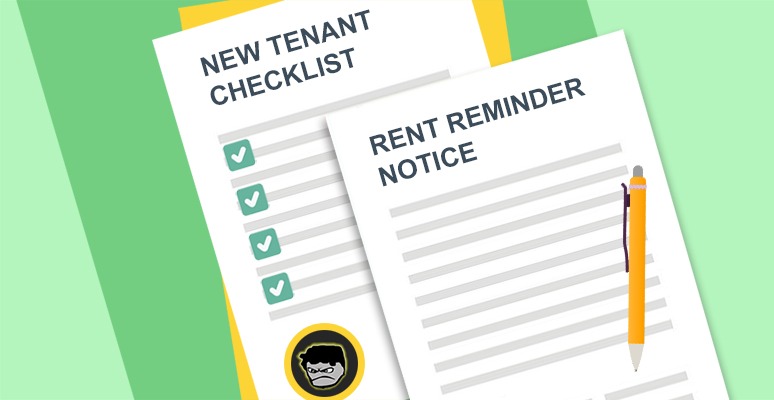
With fraudulent tenancy applications rates skyrocketing to the moon, it’s never been so important to screen tenants… the right way!
Do you know why I’ve emphasised the fact that this blog post is written by a “real landlord” [in the title]?
No? Well, it’s ’cause I’ve just spent some time researching other resources covering the same topic, and none of them seem to be written by actual landlords, but rather “property journalists”
*blank stare* That doesn’t seem ideal at all.
If there’s anything I’ve learned about screening prospective tenants during my long and painful 10+ year tenure of being a landlord, it’s that no one will do the job as effectively as me, not even managing agents – because I’m the one with skin in the game, so my only priority is to get the best possible tenants through the doors. No one else will have that same motive!
The problem with the “How to screen tenants guides” I came across is that they only cover the generic administerial procedures (e.g. credit checks, employment checks etc.) while neglecting the very real human and behavioural aspects, which I’d actually argue are equally as important indicators, if not more. I’m not saying my blog post will be any better, but I am saying that it will include more than just the objectively obvious steps. Maybe I am saying mine will be better.
In any case, if you’re a self-managing landlord that’s looking for insight on how a fellow landlord conducts their screening process, you’ve come to the right place (maybe).
I’m going to walk through my thoughts and steps on screening tenants – this is how I’ve done it for several years (after a lot of trial and error), and it’s proven to be effective so far *touches wood*
Principles of Screening Tenants
These are the principles I follow, so they’re not necessarily steps to follow (I’ll cover those after). They’re essential to my blueprint nonetheless.
It’s incredibly easy to get derailed from these, so even I have to remind myself to stay true to the course.
Screening tenants is about minimising risk
The objective is to minimise risk, that’s it.
Forgetting why we’re doing this in the first place isn’t uncommon, so it’s useful to constantly remind ourselves that every decision we make during the process of screening tenants is to protect ourselves from rogue tenants. When you remember the “why” it’s a lot easier to make sensible decisions with purpose.
There is no silver-bullet solution, but we can definitely the stack the odds in our favour.
Constantly question how and if you can improve your odds.
Do NOT waste time on time-waters!
This has to be lesson 1 (and it’s a lesson I learned after enduring many battle scars).
Screening methods can easily fall into one of two camps: efficiently (by being methodical) or chaotically (by not following a plan).
Obviously you want to be efficient, otherwise you’ll end up wasting an ungodly amount of time, money and energy on, well, time-wasters. In practical terms, all this means is that some applicants are going to be complete duds (for whateve reason), period. In those instances, their applications need to be put aside ASAP so you can move on.
This can work in two different ways:
- When there’s a lot of interest/applications – some landlords will thoroughly process each and every application (e.g. take viewings and run credit checks), even those that don’t meet the criteria on-paper. Do NOT fall down that trap. It’s better to have a system in place that will allow you to quickly separate the applications into two piles: Suitable Vs Dud (unsuitable). The unsuitable pile should be discarded like the plague and no more time should be invested on them.
- When there’s little interest/applications – the Lord knows I can empathise with an enquiry draught, it’s frustrating as hell and can be costly. In this case, the biggest trap that landlords often fall into is that they become desperate, which leads them to “polishing a turd”. In other words, they’ll waste time looking for reasons to embellish and justify an unsuitable applicant for the sake of finding a tenant.
Experience has taught me that filling vacancies out of desperation is counter-intuitive and usually ends in disaster. Patience usually always yields better long-term results.
Find the best quality tenant(s)!
The aim of the game is to find the best quality tenant for your property, it is NOT to find a tenant as quickly as possible. Of course, finding a quality tenant quickly is the ultimate outcome, but it’s important to refrain from trading quality for speed.
Please fight the urge – I know how alluring it is to fill vacancies quickly.
Once again, this often happens when landlord’s are battling against tough market conditions where interest is limited. Desperation can consume like a cancer.
Bottom of the barrel quality tenants can effortlessly cost landlords £1000s in repairs and legal costs, so it’s usually significantly more cost-effective to keep a property vacant for a little longer until a suiter comes along.
Listen to your gut instincts!

Your gut is the best bullshit detector. Trust it, even if it’s sagging down to your knees and the bane of your existence.
There have been times when my gut was screaming at me to avoid certain applicants (there was just something off about them), but all the paperwork was pulling in the other direction (i.e. they had a perfect credit score, passed the affordability test, and impeccable character references).
Almost every time I went against my gut I paid for it dearly.
No more! My gut holds a 50% equity stake along with the administrative paperwork when it comes to decision making.
It can be tough for some people (including myself, I’m an introvert), but it’s important not to be afraid to turn down applicants that you don’t feel are quite right.
(if you’re a complete div and have questionable judgement, you may want to get assistance from someone trustworthy that can assist with being your bullshit detector)
It’s a working relationship (which works both ways)
Landlords and tenants often forget that they’re entering into a relationship (that is usually long-term), and like any relationship, it requires key attributes to function properly. In this case, communication, trust and respect. Without them, the whole arrangement can quickly become dysfunctional – and the next thing you know, you’re out on the street having a fist fight in front of the neighbours.
Yes, renting out a property is a business, but it only functions properly with good people turning the cogs.
As a landlord, I want to be able to trust my tenant to look after the property, and I want them to respect me enough to communicate with me when any issues or concerns arise.
It’s important to try and identify the qualities you expect from your tenants. There is no exact science to this, and it’s largely based on assumptions during limited interactions (e.g. pre-tenancy phone calls, in-person meetings during viewings etc), so extract what you can from the moments you get. Some signs are obvious. For example, when a tenant arrives late to a viewing (which, of course, happens) and doesn’t apologise. Not only is that super weird, but it also triggers alarm bells, because it shows me an obvious lack of basic manners/respect.
In short, chemistry is important.
Take your own viewings!
I can’t bang this drum enough.
*BANG* *BANG* *BANG* *BANG*
Take. Your. Own. Damn. Viewings. Don’t get someone else to do it. If you’re using an agent, be present.
Without personally taking viewings, many of the other processes I’ve listed become difficult to accomplish.
It’s the single best opportunity to look your prospective tenant’s square in the eyes, have a conversation with them, and get a feel for their character, and your chemistry (as mentioned, this works both ways).
If you’re not convinced, here you go, you can read through all my arguments for why landlords should take their own viewings (after you’re done here though, obviously). I hope you eventually see the light.
(I appreciate this step isn’t always practical or possible, especially for overseas landlords, but I strongly encourage landlords to do it when possible)
*BANG*
*BANG* *BANG*
Steps to Screening Tenants
Run an affordability test
Determine the magic number – how much someone realistically needs to earn to comfortably afford the property. Take into consideration:
- Rent
- Utility bills (e.g. gas, electricity, water, council tax)
- Broadband/internet
- TV license
- Food/general living expenses
This will give you an idea how much your next tenant needs to be earning.
Outline your requirements and determine what kind of tenant you want
For example:
- Single, couple, family (this will likely depend on the size of your property)
- Do they need to be employed with a stable job?
- Do they require rental history?
- Are you pet-friendly?
- Are you open to DSS/Social housing tenants?
- How long is the tenancy you’re offering? (speaking of which, here’s my thoughts on how long a tenancy agreement should be)
- Do you require a guarantor?
- Do you require a deposit?
Bear in mind, the more requirements you have, the smaller your pool of potential applicants becomes (this isn’t necessarily a bad thing). With that in mind, it’s also important to be realistic about what kind of property you have on offer, and in-turn what type of tenant is likely to apply.
Clearly mention your tenancy requirements in your marketing
This will be first part of the filtering process (each filter should systematically whittle down your list) – ensure all your adverts (e.g. Rightmove / Zoopla rental listing) clearly explain your requirements.
Hopefully I don’t need to say this, but I will anyway: it is illegal for landlords to discriminate against tenants on the basis of race, gender, disability, sexuality or religion!
Mandatory rental applications
This will be the second part of the filtering process – send all interested applicants a rental application form to complete.
This form will typically ask for the following details:
- Tenancy details: number of people, proposed tenancy start date.
- Tenant’s personal details: tenant(s) name, contact details.
- Current Landlord: details of current landlord.
- Referee / Guarantor Details: details of Guarantor.
- Employment details: current and past employment details, and salary.
- Occupants: Details of all the people that will occupy the property.
- Other details: details such as smoking status, pet status.
Download a sample rental application form.
Schedule viewings with appropriate applicants
Schedule viewings with the applicants that seem most promising based on the details you receive in the completed application forms.
Now, onto the third part of the filtering process – as mentioned, the viewing will be a perfect opportunity to get to know your applicant better. Do not waste the opportunity, and do not be afraid to ask questions.
Referencing & Credit checks
We’re here, the fourth and final part of the filtering process – reference and credit check the applicants that you’re most impressed by. Bear in mind there are costs associated to tenant referencing and credit checks, so in a heated rental market (i.e. when dozens of applicants apply for the same vacancy) you may need to be particularly cut-throat to whittle down your short-list.
The process of referencing & credit checks should include (not all will be relevant in every cases):
- Contacting previous landlords for references
- Contacting employer for references
- Request recent payslips as proof of income (typically 3 – 6 months worth)
- Request recent bank statements (typically 3 – 6 months worth). On a crucial side note, there’s been an alleged increase in applicants using fake payslips to apply for properties. To safeguard against this risk, it’s always useful to cross-reference the payslips with bank statements (which is actually why it’s useful to request both).
- Confirm identity of applicants (i.e. check passport, photo issued driving license)
- Run credit checks on applicants (you can use various tenant credit check services.
- Run credit checks on applicants guarantor (many landlords miss this part, but it’s crucial to ensure the guarantor is suitable)
List of tenant credit check services – approx price is £15 per credit check.
Pick the most suitable applicant
Hopefully by this stage – after running various filtering processes – you should have at least one suitable applicant.
Again, I want to emphasise that quality trumps speed every time, so from my experience, it’s always worth holding out for suitable applicants.
There’s no shortage of fraudulent tenancy applicants!
Buyer beware!
Needless to say, the rental industry is riddled with monkey business. It’s the wild, wild west.
According to the 2020 Fraud and Corruption Tracker by the Chartered Institute of Public Finance and Accountancy (CIPFA), false tenancy applications are the fastest-growing area of housing fraud, costing an estimated £60.1m in the UK.
Source: Property Industry Eye
Some of the common techniques used by fraudsters for tenant applications include:
- Fake IDs e.g. passports and driving licences
- Doctored documentation e.g. payslips and bank statements
- Fake references
So, consider this a friendly reminder of why being thorough during your screening process is critical, and why using a professional referencing service is a sharp idea.
The final point I want to make is that one size doesn’t always fits all – my blueprint of screening tenants is just that, my blueprint. It works for me, but it’s also adaptable and constantly evolving.
Create what works for you.
Happy hunting xo
Disclaimer: I'm just a landlord blogger; I'm 100% not qualified to give legal or financial advice. I'm a doofus. Any information I share is my unqualified opinion, and should never be construed as professional legal or financial advice. You should definitely get advice from a qualified professional for any legal or financial matters. For more information, please read my full disclaimer.


 Landlord Products / Services
Landlord Products / Services






















